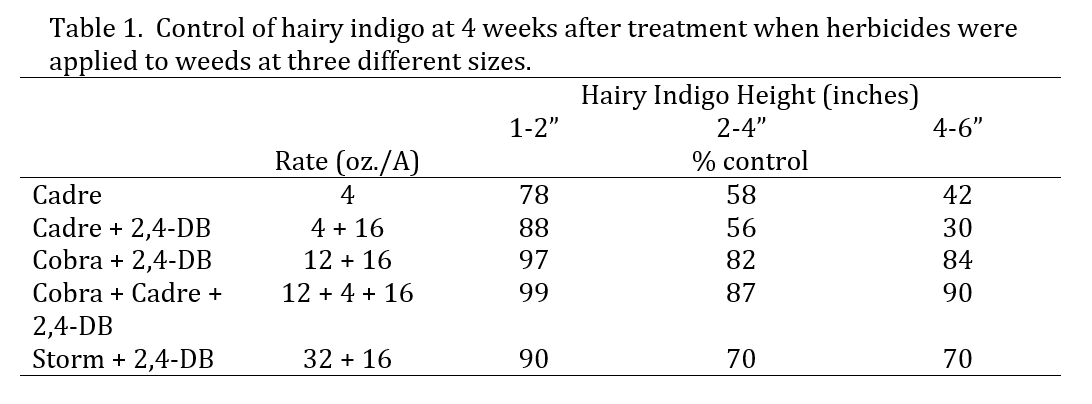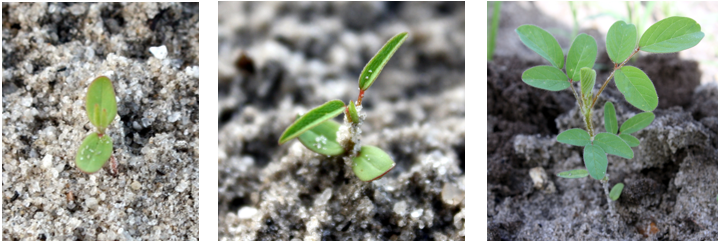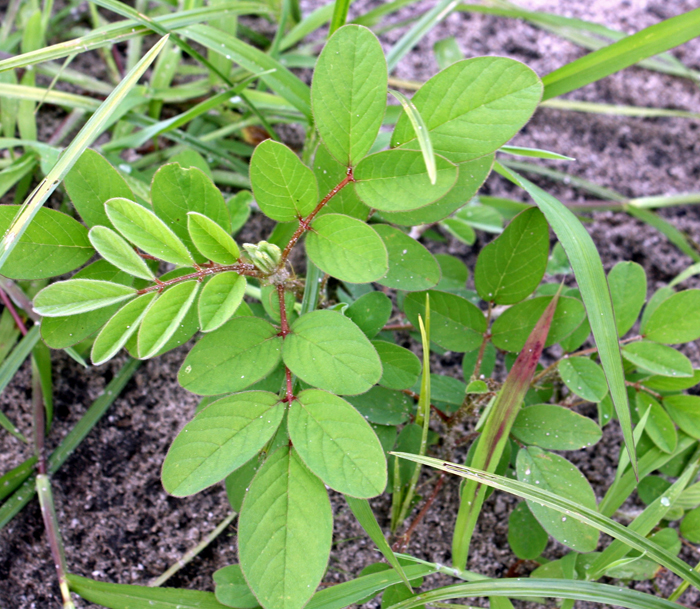B. Colvin, J. Ferrell, and R. Leon
Hairy indigo (Indigofera hirsuta) is an annual legume that was introduced to Florida as a forage crop. It has since escaped cultivation where it can be a troublesome weed in some crop settings. Hairy indigo is particularly difficult to manage in peanut production since we are attempting to control a legume weed in a legume crop.
Hairy indigo germinates in late spring and continues throughout the summer. In general, it is the later emerging (late May through June) individuals that are often the most problematic since many of the postemergence herbicides have already been applied. Hairy indigo commonly grows between 2 and 5 feet in height and the stem becomes increasingly woody with age. As the name would suggest, the leaves are covered with a very dense mat of fine hairs that increase in thickness with age.
Hairy indigo in peanut can reduce yield by two ways. 1. The plant gains a significant height advantage over peanut and forms a dense canopy. This reduces photosynthesis, but also intercepts fungicide and leads to great disease incidence. 2. The woody stems of hairy indigo complicate the peanut digging process and significant peanut yield loss can result.
Control
Few soil-applied herbicides have been found to adequately control hairy indigo. This, plus the fact that this weed has a long germination window, generally means that preemergence herbicides are of marginal value on this weed. Therefore, postemergence herbicides were tested to determine which program would adequately control this plant.
Experiments conducted at the University of Florida tested five herbicide combinations on hairy indigo that was 1-2”, 2-4”, and 4-6” in height. All herbicides were applied with crop oil at 1% v/v.
Hairy indigo control, when sprayed at the 1-2” stage, was acceptable for all herbicides tested (Table 1). Cadre alone provided a modest 78% control, but the Cobra and Storm treatments all provided 90% control or greater. Surprisingly, allowing the plants to reach 2-4” in height dramatically impacted control. This small difference in plant height reduced control by 12 to 32% for all treatments. As the plants reached 4-6” in height, the Cadre treatments were decreased yet again to 30-42%. However, control from the Cobra and Storm treatments stayed relatively stable as height increased from 2-4” to 4-6”.  This rapid reduction in herbicide activity was somewhat expected since the density of leaf hairs increases rapidly as the plants pass out of the seedling stage. These thick hairs intercept the herbicide and prohibit the droplet from absorbing into the leaf.
This rapid reduction in herbicide activity was somewhat expected since the density of leaf hairs increases rapidly as the plants pass out of the seedling stage. These thick hairs intercept the herbicide and prohibit the droplet from absorbing into the leaf.

Size really matters for controlling hairy indigo. 1-2″ seedlings are much easier to control than 4-6″ seedlings. Photo Credit: Jay Ferrell
These data indicate that hairy indigo is a weed that can be managed with our current peanut production practices. However, if this weed has been a problem in the past, it is essential to scout these fields often and prepare to spray when the weeds are small. But it must be noted that applications of Cobra should be used with caution if the peanut crop is greater than 8 weeks old. Numerous trials have shown that yield reduction will commonly occur if Cobra is sprayed at this time. If hairy indigo is present late in the season, it would be advisable to use Storm + 2,4-DB to manage the weed.
For more information on Peanut Weed Control, download:
Weed Management in Peanuts
- The How and Why of Preemergence Herbicide Incorporation for Row Crops - April 28, 2017
- Using Dicamba on Dicamba-Tolerant Crops - March 3, 2017
- Managing Dicamba Drift when using New Dicamba Resistant Cotton Varieties - January 27, 2017

